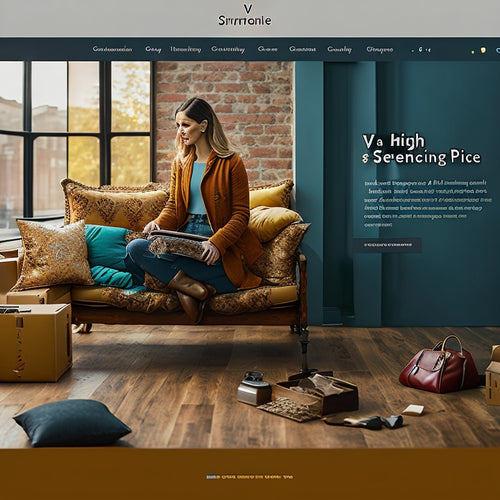
What Drives Customer Loyalty in Online Shopping?
Share
When it comes to online shopping, you know that building trust and transparency is key to driving customer loyalty. In fact, 94% of customers prefer brands that offer transparency. Personalization also plays a significant role, as tailored experiences and product recommendations create a sense of appreciation and loyalty. Seamless omnichannel engagement, rewarding customer advocacy, and consistent communication are also essential. But that's not all - emotional connections, valuing customer feedback, and creating memorable experiences all contribute to long-term loyalty. By focusing on these elements, you'll be well on your way to turning browsers into loyal customers, and revealing the full potential of your online store, where the real magic happens.
Key Takeaways
• Transparency and clarity in product descriptions, shipping, and return policies instill trust and security, driving customer loyalty.
• Personalized product recommendations and tailored experiences based on user behavior analysis foster loyalty and appreciation.
• Seamless omnichannel engagement through integrated marketing strategies and cohesive interactions enhance customer value and loyalty.
• Rewarding customer advocacy through loyalty incentives, VIP programs, and recognition systems creates brand ambassadors and encourages positive word-of-mouth.
• Consistent communication, proactive issue resolution, and clear expectations management build trust and loyalty by preventing negative reviews and escalating problems.
Building Trust With Transparency
When you shop online, clarity is key to building trust, and transparency is the cornerstone of that clarity, as it allows you to make informed purchasing decisions and feel confident in your choices.
You crave authenticity, and rightly so. Transparency breeds trustworthiness, which is essential for online retailers to establish a loyal customer base. A study by Label Insight found that 94% of customers are more likely to be loyal to a brand that offers transparency.
This isn't surprising, given that transparency instills a sense of security and authenticity, making you more likely to return to a site that prioritizes openness. By being upfront about product information, shipping details, and return policies, online retailers can demonstrate their commitment to trustworthiness.
This, in turn, fosters a sense of loyalty, as you feel valued and respected as a customer. As you navigate the online shopping landscape, prioritize sites that prioritize transparency – your trust, and ultimately, your loyalty, depend on it.
Personalization in Online Experience
As you navigate online stores, you expect a tailored experience that mirrors your unique preferences and shopping habits.
To achieve this, online retailers can leverage personalization strategies that make you feel seen and valued.
Tailored Product Recommendations
On average, 71% of online shoppers are more likely to return to a website that offers personalized product recommendations, making tailored suggestions a key driver of customer loyalty in the digital marketplace. You're more likely to come back to a site that knows you and your preferences. Customized recommendations don't just increase the chances of you buying more; they also boost customer engagement. You feel seen and understood when a brand takes the time to suggest products that align with your interests and needs.
Personalized suggestions create a tailored experience that's hard to find elsewhere. You're not just browsing through a generic catalog; you're exploring a curated selection of products that speak directly to you. This level of personalization fosters a sense of loyalty and appreciation, making you more likely to return to the site and recommend it to others.
Dynamic Content Adaptation
You're 45% more likely to engage with a website that dynamically adapts its content to your preferences, making dynamic content adaptation an essential element in crafting a personalized online experience. This is where user behavior analysis comes into play, as it allows e-commerce sites to gather valuable insights into your online habits and tailor their content accordingly.
By leveraging this data, websites can create a more intimate connection with you, showcasing products and offers that resonate with your interests and needs.
Content personalization is key to this approach. When a website acknowledges your preferences and adapts its content to match, you're more likely to feel seen and valued as a customer. This, in turn, fosters a sense of loyalty and trust, driving you to return to the site time and again.
Dynamic content adaptation is no longer a nice-to-have; it's a must-have for e-commerce sites seeking to stay ahead of the competition. By putting the customer at the forefront of their strategy, businesses can reap the rewards of increased engagement, conversion rates, and, ultimately, customer loyalty.
Seamless Shopping Journey
By tailoring the online experience to your unique preferences, e-commerce sites can create a seamless shopping journey that mirrors the personalized interactions you'd expect from a brick-and-mortar store. This is achieved through advanced analytics and machine learning algorithms that learn your behavior and adapt the experience accordingly.
Here are some ways online retailers can create a seamless shopping journey:
-
Personalized product recommendations: receive suggestions based on your browsing and purchase history, making it more likely you'll find what you're looking for.
-
Streamlined checkout processes: with auto-filled forms and saved payment methods, you can complete your purchase quickly and effortlessly.
-
Relevant content and offers: receive targeted promotions and content that resonate with your interests and needs, making you feel valued and understood.
-
User-friendly interface: easily navigate the site and find what you need with an intuitive and responsive design.
-
Enhanced convenience: enjoy features like one-click ordering, easy returns, and real-time order tracking, making your online shopping experience hassle-free.
Seamless Omnichannel Engagement
Across all touchpoints, from social media to in-store experiences, customers expect seamless omnichannel engagement, where their interactions with your brand are cohesive, personalized, and consistent. You need to make sure that your marketing strategies are integrated, providing a unified experience across all channels. This means that your social media, email, and in-store promotions should all be aligned, speaking to your customers in a consistent tone and voice.
| Channel | Customer Expectation |
|---|---|
| Social Media | Receive customized offers and content |
| Obtain exclusive deals and loyalty rewards | |
| In-store | Enjoy smooth checkout and personalized service |
Rewarding Customer Advocacy
As customers become loyal advocates, they expect to be rewarded for their loyalty, and recognizing and incentivizing their positive word-of-mouth, online reviews, and social media endorsements is vital.
You can't afford to ignore their efforts, as they're essentially carrying out your marketing for you. By implementing effective advocacy programs, you can encourage more customers to become brand ambassadors.
Here are some ways to reward customer advocacy:
-
Offer loyalty incentives, such as points or discounts, for leaving reviews or referring friends
-
Provide exclusive customer rewards, like early access to new products or limited-time offers
-
Give referral bonuses for successful referrals, such as discounts or free merchandise
-
Create a VIP program with special perks and benefits for your most loyal customers
-
Develop a leaderboard or recognition system to publicly acknowledge your top advocates
Consistent Communication Matters
When you shop online, you expect transparency and reliability from retailers. Consistent communication plays an important role in meeting these expectations, and it's vital to set clear expectations and proactively resolve issues to build trust with your customers.
Clear Expectations Set
By clearly outlining shipping timelines, return policies, and product details, you empower customers to make informed purchasing decisions, which in turn fosters trust and loyalty in your online brand. This transparency helps in setting boundaries and managing expectations, ensuring that customers know what to expect from their online shopping experience.
Here are some key aspects to focus on:
-
Product descriptions: Provide detailed, accurate, and up-to-date product information to avoid misconceptions.
-
Shipping timelines: Clearly outline estimated delivery dates and any possible delays.
-
Return policies: Specify the return window, process, and any associated fees.
-
Product images: Use high-quality images that showcase the product from different angles.
-
Reviews and ratings: Encourage customers to leave reviews and ratings to build trust and credibility.
Proactive Issue Resolution
Resolving issues proactively through consistent communication is critical to building customer loyalty, as it shows you're invested in their satisfaction and willing to make things right when problems arise. When you're proactive, you're not just reacting to issues, you're anticipating and preventing them. This approach demonstrates a commitment to your customers' needs, fostering trust and loyalty.
In today's digital landscape, timely resolution is key. According to a study, 75% of customers expect a response to their complaints within an hour. Meeting this expectation requires a proactive customer service strategy that prioritizes swift issue resolution. By doing so, you'll not only resolve problems efficiently but also prevent escalation and potential negative reviews.
Emotional Connection With Brands
Establishing an emotional connection with a brand is essential, as it makes you, the customer, more invested in their story, values, and mission, ultimately driving loyalty and repeat business. When you feel a strong emotional resonance with a brand, you're more likely to become a loyal advocate and repeat customer.
Here are some ways brands can create an emotional connection with you:
-
Authentic brand storytelling: When brands share their mission, values, and story in a genuine and transparent way, it creates a sense of connection and trust.
-
Shared values and beliefs: When you share values and beliefs with a brand, you're more likely to feel a sense of loyalty and attachment.
-
Empathy and understanding: Brands that show empathy and understanding towards their customers' needs and concerns create a sense of emotional connection.
-
Personalization and recognition: When brands personalize their communication and recognize your individuality, it creates a sense of belonging and loyalty.
-
Consistency and reliability: Consistent and reliable brands build trust and create an emotional connection with customers.
Valuing Customer Feedback Loops
You're more likely to stick with a brand that actively seeks and incorporates your feedback, demonstrating that your voice matters in shaping their products and services. This is because customer feedback loops show that the brand values your input and is committed to continuous improvement. By doing so, they're able to refine their offerings to better meet your needs, fostering a sense of customer engagement.
| Benefits of Customer Feedback Loops | Impact on Customer Loyalty |
|---|---|
| Improved product quality | Increased satisfaction and trust |
| Enhanced customer experience | Stronger emotional connection |
| Personalized communication | Feeling of being heard and valued |
| Data-driven decision making | Increased loyalty and retention |
Creating Memorable Unboxing
When your package arrives, the unboxing experience can be a pivotal moment in shaping your perception of a brand, with thoughtful packaging design and attention to detail making all the difference in creating a memorable and shareable event.
A well-crafted unboxing experience can foster brand loyalty, as customers feel appreciated and valued.
Here are some ways to create a memorable unboxing experience:
-
Customized packaging: Tailor your packaging to your brand's unique voice and aesthetic, making it instantly recognizable and Instagram-worthy.
-
Personalized notes: Include handwritten notes or personalized messages to create a sense of connection and human touch.
-
Premium materials: Use high-quality materials that reflect the value of your product, conveying a sense of luxury and sophistication.
-
Functional design: Design packaging that serves a purpose beyond just holding the product, such as reusable bags or containers.
-
Surprise and delight: Add a little something extra, like a free gift or a discount code, to leave a lasting impression and encourage repeat business.
Surprising With Delightful Moments
By incorporating delightful surprises into your unboxing experience, you can create an emotional connection with customers, fostering loyalty and encouraging them to share their positive experiences with others. This strategy is rooted in the psychology of pleasure and surprise, which can lead to a significant increase in customer loyalty. In fact, research shows that unexpected surprises can boost customer satisfaction by up to 25%.
To surprise and delight your customers, consider adding a personalized note, a free sample, or a limited-time discount to their package. These small gestures can lead to a significant increase in customer retention and advocacy. Additionally, delighted customers are more likely to share their experiences on social media, generating buzz and driving new sales.
Frequently Asked Questions
How Do Online Shoppers Define a Seamless Checkout Experience?
When you're shopping online, you crave a checkout experience that's smooth sailing, not a frustrating obstacle course. You define seamless as mobile optimization, multiple payment options, a user-friendly interface, and speedy delivery - anything less feels like a deal-breaker.
Can Ai-Powered Chatbots Replace Human Customer Support?
You'll find that AI-powered chatbots can efficiently handle routine inquiries, but they often lack the human touch that drives customer satisfaction; to truly personalize experiences, you'll need a strategic blend of chatbot efficiency and human empathy.
What Is the Ideal Frequency for Promotional Email Campaigns?
You're worried that frequent promotional emails will annoy customers, but research shows that tailored, regular emails can boost email engagement and conversion rates, as long as you respect customer preferences and adapt marketing tactics accordingly.
Do Loyalty Programs Really Increase Customer Retention Rates?
You'll find that loyalty programs can boost customer retention rates when they foster genuine customer engagement, build brand trust, and offer personalized experiences that drive customer satisfaction, ultimately leading to long-term loyalty.
How Can E-Commerce Sites Ensure Secure and Trusted Payment Gateways?
You establish secure and trusted payment gateways by implementing robust payment security measures, displaying trust badges, and providing transparent payment information, thereby building trust and increasing conversions by up to 20%.
Related Posts
-
Leveraging Social Proof: the Impact of Ugc Shoppable Videos
In today's digital landscape, businesses are constantly seeking innovative ways to drive sales and connect with thei...
-

Efficiently Automate Your Shopify Store for Success
The automation of Shopify stores has become increasingly popular due to its potential benefits and the availability ...
-

Introduction to Blogging in Shopify: A Step-by-Step Guide
This article serves as an informative guide to the process of blogging in Shopify. Blogging is a valuable tool for o...

